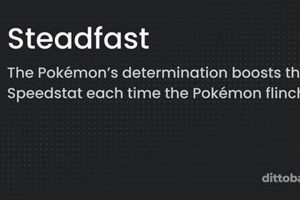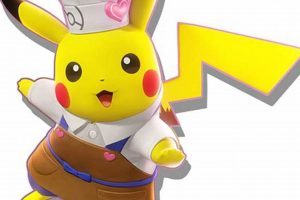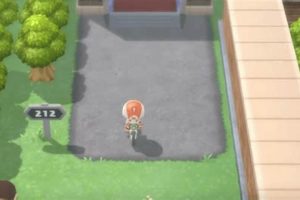Released in 2010, Pokmon HeartGold is a role-playing video game, a remake of the 1999 Game Boy Color title Pokmon Gold. It revitalized the classic Johto region adventure for a new generation of players while retaining the core gameplay mechanics and story elements of the original. The title also introduced updated graphics, sound, and features, enhancing the overall experience for both veteran and new players.
Its importance lies in its successful revitalization of a beloved entry in the Pokmon series, demonstrating the enduring appeal of classic gameplay. Benefits included the introduction of the “Pokmon following” mechanic, allowing the lead Pokmon to visually accompany the player throughout the game, fostering a deeper connection. The historical context is significant as it arrived during a period of increasing nostalgia for retro games, showcasing the value of reimagining established franchises for modern audiences.
The following sections will delve into specific aspects of the game, including its core mechanics, innovative features, and the impact it had on the wider Pokmon franchise, offering a detailed exploration of its lasting legacy.
Success in the Johto region requires strategic planning and careful resource management. The following tips aim to provide guidance for maximizing the gaming experience.
Tip 1: Utilize the Pokwalker Device. The included Pokwalker accessory allows for training a Pokmon outside of active gameplay. Transferring a Pokmon to the Pokwalker and accruing steps can result in increased experience points and the discovery of rare items, providing a significant advantage upon its return to the main game.
Tip 2: Master the Breeding Mechanics. Breeding Pokmon at the Day-Care center in Goldenrod City is crucial for acquiring Pokmon with specific natures, abilities, and moves. Understanding IVs (Individual Values) and EVs (Effort Values) will allow for the creation of more powerful and competitive teams.
Tip 3: Exploit Type Matchups. A thorough understanding of the Pokmon type chart is essential for success in battles. Identifying weaknesses and resistances will enable efficient and effective combat strategies, especially against challenging Gym Leaders and Elite Four members.
Tip 4: Manage Resources Effectively. Conserve valuable items such as Potions, Revives, and TMs. These resources are often scarce, and judicious use will ensure survival in difficult situations. Avoid unnecessary consumption and prioritize their use during critical battles.
Tip 5: Explore All Available Routes. The Johto region contains numerous hidden areas and secret items. Thorough exploration of each route and town is necessary to uncover valuable resources and encounter rare Pokmon, contributing to a more complete and rewarding experience.
Tip 6: Leverage the Radio Functionality. The Radio function on the Pokgear can be utilized to attract specific Pokmon to certain areas. Tuning into specific frequencies, particularly the Hoenn Sound and Sinnoh Sound, increases the likelihood of encountering Pokmon from other regions, expanding available team options.
These strategies, when applied thoughtfully, can significantly improve the player’s ability to progress and excel. Mastering these elements facilitates a richer, more rewarding gaming experience.
The following sections will explore additional strategies and considerations for mastering the challenges present within the game.
1. Johto Remastered
The phrase “Johto Remastered” directly relates to Pokmon HeartGold. It signifies the comprehensive updating and re-imagining of the Johto region, originally featured in the 1999 release Pokmon Gold, for the Nintendo DS platform in 2010. As a component of the 2010 release, “Johto Remastered” encompasses not only visual enhancements but also refinements to gameplay mechanics, sound design, and overall presentation. Without this foundational overhaul, Pokmon HeartGold would merely be a direct port, lacking the appeal and advancements expected of a modern remake. The cause of creating HeartGold was that it was effect from old pokemon games such as the Johto region.
For example, the original Pokmon Gold featured rudimentary 8-bit graphics. “Johto Remastered” translates this into detailed 3D environments and character models. Similarly, the limited sound capabilities of the Game Boy Color were replaced with orchestrated music and enhanced sound effects. The practical significance of understanding “Johto Remastered” lies in recognizing its impact on the game’s accessibility and enjoyment for both veteran fans and newcomers. It bridges the gap between classic gameplay and contemporary expectations, attracting a wider audience.
In conclusion, “Johto Remastered” is not just a descriptor but rather a core element of Pokmon HeartGold, responsible for its modernized presentation and broader appeal. It represents a deliberate effort to retain the essence of the original while delivering a substantially enhanced and updated gaming experience, ensuring the game’s relevance and popularity in 2010 and beyond.
2. Pokewalker Innovation
The inclusion of the Pokwalker device in Pokmon HeartGold represents a significant innovation within the handheld gaming landscape. This peripheral extended gameplay beyond the confines of the Nintendo DS console, encouraging physical activity and enhancing the overall experience.
- Step-Based Progression
The Pokwalker measured physical steps taken by the user. These steps translated into in-game rewards, allowing players to level up their Pokmon and find items outside of the traditional gameplay environment. This system incentivized physical activity and fostered a deeper connection between the player and their virtual companion.
- Wireless Connectivity
The device communicated wirelessly with the Nintendo DS cartridge, allowing players to transfer Pokmon to and from the Pokwalker. This seamless integration eliminated the need for cumbersome cables and simplified the process of managing and training Pokmon on the go.
- Exclusive Content
The Pokwalker featured unique routes and Pokmon not available within the main game. This exclusivity encouraged players to actively utilize the device to expand their collection and unlock rare content, adding replayability and depth to the overall experience.
- Social Interaction
While limited, the Pokwalker allowed for infrared communication between devices, enabling players to exchange items and data with others. This rudimentary form of social interaction added a layer of community engagement, encouraging players to connect and share their experiences.
The Pokwalker’s innovative integration of physical activity, wireless technology, and exclusive content significantly enhanced the appeal and replayability of Pokmon HeartGold. This peripheral remains a notable example of how developers can extend the gameplay experience beyond the screen, fostering a more engaging and rewarding interaction with the virtual world.
3. Following Pokmon
The “Following Pokmon” mechanic, a feature prominently implemented in the 2010 release of Pokmon HeartGold, represents a significant enhancement to the immersive quality of the game. This functionality allows the first Pokmon in a player’s party to visually accompany the character’s avatar on the overworld map, mirroring the player’s movements and actions. The inclusion of this feature is not merely cosmetic; it fosters a stronger sense of connection between the player and their chosen Pokmon, a relationship previously limited to battles and menu interactions. The cause for its inclusion stems from player desire for greater interaction with their Pokmon, an effect realized by this visual representation.
The practical significance of this feature is multifaceted. Firstly, it contributes to a more personalized and engaging experience. Players develop preferences for particular Pokmon based not only on their stats and abilities but also on their visual presence and animations within the game world. Secondly, this mechanic provided a sense of novelty and charm, particularly appealing to long-time fans of the Pokmon series. For example, witnessing a large Pokmon such as an Onix trailing behind the player’s character added a unique visual element to exploration and traversal of the game’s environments. This visual reinforcement enhanced immersion and player investment.
In conclusion, the “Following Pokmon” feature of Pokmon HeartGold is a key component of its success, adding depth and engagement. This seemingly minor alteration to the gameplay formula resulted in a significant increase in player immersion, personal investment, and overall enjoyment of the game. This feature, though not essential for core gameplay, became a hallmark of the experience and contributed significantly to its lasting legacy.
4. Enhanced Graphics
In the context of Pokmon HeartGold, released in 2010, the term “Enhanced Graphics” signifies a substantial visual upgrade compared to its predecessor, the 1999 Pokmon Gold for the Game Boy Color. This enhancement is a critical factor in the remake’s appeal, modernizing the experience for a new generation of players and satisfying expectations for visual fidelity on the Nintendo DS platform.
- Improved Sprite Design and Detail
The original Pokmon Gold utilized rudimentary 8-bit sprites, characterized by limited color palettes and low resolution. HeartGold replaced these with more detailed and expressive 2D sprites for Pokmon and characters. This improvement resulted in more visually appealing representations of the creatures and personalities, contributing to a more immersive world.
- 3D Environments and Perspective
While still primarily a 2D game, HeartGold incorporated 3D environments to create a sense of depth and scale previously unavailable. Certain camera angles and environmental details were rendered in 3D, enhancing the overall visual presentation and contributing to a more engaging exploration experience. For example, the Sprout Tower featured a noticeable elevation difference between floors, visually emphasizing the height.
- Animated Cutscenes and Effects
HeartGold introduced animated cutscenes and special effects that were absent in the original. These sequences added visual flair to key story moments and battles, heightening the dramatic impact and providing a more cinematic feel. The use of particle effects and dynamic lighting further contributed to the overall visual polish.
- Enhanced Color Palette and Visual Clarity
The limitations of the Game Boy Color’s color palette resulted in a somewhat muted and pixelated visual experience in Pokmon Gold. HeartGold utilized the Nintendo DS’s expanded color capabilities to create a more vibrant and visually clear world. This improved visual clarity made the game more accessible and enjoyable, particularly for players accustomed to more modern visual standards.
These facets of “Enhanced Graphics” were instrumental in revitalizing the Pokmon Gold experience for a 2010 audience. By modernizing the visuals while retaining the core gameplay and story, HeartGold successfully bridged the gap between nostalgia and contemporary expectations, securing its place as a critically acclaimed and commercially successful remake.
5. Dual Region
The “Dual Region” aspect of the 2010 release, Pokmon HeartGold, constitutes a core element of its gameplay depth and longevity. This feature provides players with the opportunity to explore not only the Johto region, the setting of the original Pokmon Gold, but also the Kanto region, the setting of the original Pokmon Red and Blue games. This dual exploration significantly expands the scope of the game and provides a substantial amount of post-game content.
- Expanded Playtime and Content
The inclusion of the Kanto region essentially doubles the playable area, offering players a wealth of additional towns, routes, and Gym Leaders to challenge. This dramatically increases the game’s playtime and provides a substantial reward for completing the initial Johto storyline. This added content contributes to the game’s lasting appeal and replay value.
- Revisiting Familiar Locations
For players familiar with the original Pokmon Red and Blue, the Kanto region offers a nostalgic journey through familiar landscapes and locations. This allows players to revisit iconic areas like Pallet Town, Viridian Forest, and Mt. Moon, experiencing them with updated graphics and gameplay mechanics. This aspect caters to long-time fans of the series and provides a rewarding sense of familiarity.
- New Challenges and Pokmon Encounters
The Kanto region introduces new challenges in the form of stronger Gym Leaders and unique Pokmon encounters. This ensures that players are constantly tested and incentivized to refine their teams and strategies. The availability of different Pokmon in Kanto expands the player’s team-building options and adds to the overall strategic depth of the game.
- Post-Game Story and Objectives
Access to the Kanto region is unlocked after completing the main storyline in Johto, providing a clear post-game objective. This prevents the game from ending abruptly after defeating the Elite Four, offering players a compelling reason to continue exploring and progressing. The inclusion of new story elements and objectives in Kanto further enhances the post-game experience.
The “Dual Region” feature in Pokmon HeartGold serves as a significant selling point, offering a substantial amount of additional content and replay value. By combining the Johto and Kanto regions, the game provides a comprehensive and rewarding experience for both new and returning players, solidifying its position as a definitive entry in the Pokmon series. This strategic decision to incorporate two full regions significantly contributed to the game’s critical acclaim and commercial success.
6. Nostalgic Appeal
Pokmon HeartGold, released in 2010, leverages nostalgic appeal as a central component of its design and marketing strategy. The game serves as a remake of the 1999 Game Boy Color title, Pokmon Gold. The cause of its success lies in its capacity to evoke fond memories and positive emotions associated with the original game, coupled with modernized gameplay and graphical enhancements. The developers intentionally capitalized on the pre-existing emotional connections held by many players who experienced Pokmon Gold during their childhood or adolescence. This strategy allowed the game to tap into a built-in audience predisposed to embrace a re-imagining of a beloved classic. The importance of nostalgic appeal is apparent in its influence on purchasing decisions, prompting consumers to acquire the game based on positive past experiences.
A tangible example of this is evident in the game’s faithfulness to the original storyline, characters, and key locations. While graphical updates and new features were implemented, the core narrative and essential gameplay elements remained largely unchanged. This careful balance between modernization and preservation allowed the game to appeal to both veteran players seeking a nostalgic experience and new players discovering the Johto region for the first time. Furthermore, the inclusion of the Pokwalker accessory, while technologically novel, echoed the physical play and exploration associated with earlier Pokmon releases, further solidifying the connection to past experiences.
Understanding the power of nostalgic appeal in the context of Pokmon HeartGold is practically significant for analyzing the broader trends within the video game industry. The game’s success highlights the effectiveness of remakes and reboots that cater to established fan bases while simultaneously attracting new audiences. The challenge lies in striking a balance between honoring the original material and introducing meaningful enhancements that justify the remake’s existence. Pokmon HeartGold demonstrates a successful approach to this challenge, offering a compelling blend of familiar elements and modernized features that resonate with both nostalgic sentiment and contemporary gaming expectations.
Frequently Asked Questions About Pokmon HeartGold (2010)
The following questions address common inquiries and provide clarification regarding key aspects of the 2010 release, Pokmon HeartGold.
Question 1: What distinguishes Pokmon HeartGold from its original counterpart, Pokmon Gold?
Pokmon HeartGold is a complete remake of Pokmon Gold, featuring updated graphics, sound, and gameplay mechanics. Key enhancements include the inclusion of the Pokwalker device, the “Following Pokmon” mechanic, and expanded post-game content.
Question 2: Is the Pokwalker accessory essential for completing Pokmon HeartGold?
The Pokwalker accessory is not essential for completing the main storyline; however, it provides access to exclusive content and training opportunities, enhancing the overall experience.
Question 3: Does Pokmon HeartGold support online multiplayer functionality?
Pokmon HeartGold supports online trading and battling via the Nintendo Wi-Fi Connection service, allowing players to interact with others globally. Please note that the Nintendo Wi-Fi Connection service for Nintendo DS is no longer active.
Question 4: Are there any significant differences between the Pokmon available in Pokmon HeartGold and Pokmon SoulSilver?
Certain Pokmon are version-exclusive, meaning they are only obtainable in one of the two games. This encourages trading between players to complete the Pokedex. The storyline remains consistent across both versions.
Question 5: What are the key advantages of exploring both the Johto and Kanto regions?
Exploring both Johto and Kanto provides access to a wider variety of Pokmon, Gym Leaders, and challenges, significantly extending the game’s playtime and offering a more comprehensive experience.
Question 6: Does Pokmon HeartGold offer any content beyond the main storyline and the Kanto region?
Beyond the main storyline and Kanto region, Pokmon HeartGold features additional post-game challenges, including rematches with Gym Leaders, battles against powerful trainers, and the opportunity to collect legendary Pokmon.
In summary, Pokmon HeartGold presents a comprehensive and modernized re-imagining of a classic game, offering both nostalgic appeal and enhanced gameplay for a wide range of players. Its features and content significantly expand upon the original release.
The following sections will delve into specific strategies for optimal gameplay within Pokmon HeartGold.
Conclusion
This exploration of 2010 Pokmon HeartGold has elucidated key aspects of its enduring appeal. The revitalization of the Johto region, coupled with innovative features like the Pokwalker and the “Following Pokmon” mechanic, contributed significantly to its success. Furthermore, the enhanced graphics and the inclusion of the Kanto region provided a comprehensive and satisfying gaming experience, appealing to both veteran players and newcomers.
The sustained relevance of 2010 Pokmon HeartGold underscores the importance of balancing nostalgia with innovation in game development. Its success serves as a testament to the enduring power of the Pokmon franchise and its ability to captivate audiences across generations. Further research into player engagement and the long-term impact of remakes could yield valuable insights for the future of the gaming industry.







